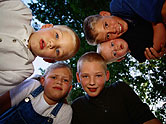
FRIDAY, Feb. 25 (HealthDay News) — A fresh look at 19th century Mormon marriage has found that the more wives to a family, the fewer offspring any one wife produced.
“Although it’s great in terms of number of [overall] children . . . the data show that for every new woman added to a male’s household, the number each wife produced goes down by one child or so,” study author and evolutionary biologist Michael Wade, from Indiana University in Bloomington, said in a university news release.
To arrive at this conclusion, Wade and his colleagues reviewed the detailed records kept by the Utah Population Database regarding the births, marriages and deaths of 186,000 adults and 630,000 children who lived there between 1830 and 1894.
During that time-frame, marriages based on a system of a single husband and multiple so-called “sister-wives” began to be phased out in response to internal social shifts within the Mormon church, as well as new federal legislation banning the practice, the study authors noted.
In addition to the primary finding, the investigators also found support for a long-standing notion that polygamy isn’t a universally good deal for all men, dividing them into haves (those with many wives) and have-not’s (those with none).
“When the ratio of sexes is about equal, for every male that has three mates, there must be two males that have none,” Wade said. “If a male has even more mates, then the disparity among male ‘reproductive’ haves and have-not’s can become quite great.”
In the world of 19th-century Mormon families, this meant that as polygamy fell to the wayside, the reproductive playing field evened out with an increasingly broader group of Mormon men experiencing both mating and reproductive “success,” according to the report in the March issue of Evolution and Human Behavior.
The research was funded by the U.S. National Institutes of Health and the National Science Foundation.
More information
The University of Utah has more at their Genetic Science Learning Center.

